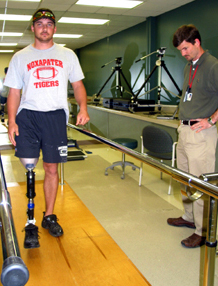FLOWOOD, Miss.—A mere three months after doctors amputated his right leg, Patrick Schoolar returned to Noxapater High School determined to embrace all the demands of being defensive coordinator for a winning high school football team.
So it was obvious that not any old prosthetic leg would pass muster with the extremely active 25-year-old coach. He needed something reliable for the classroom and something rugged for the football field. He found both at Methodist Orthotics and Prosthetics in Flowood, where a team of certified professionals fit Schoolar with a set of custom-designed artificial limbs.
During the school day, Schoolar now wears a C-Leg, a marvel of computerized machinery that can sense subtle shifts in the terrain beneath his feet. On the football field, he switches to a sturdy hydraulic leg that’s tough enough to take a tackle along the sidelines.
The state-of-the-art legs allow Schoolar to get back to business as usual, and that’s the way he likes it. “Dwelling on it isn’t going to bring my leg back, so I might as well keep going,” says Schoolar, who returned to work March on 21 and just finished spring practice with his team.
Looking back, Schoolar feels fortunate to be alive. On Tuesday, Dec. 21, a hunting buddy accidentally shot “a hole as big as two fists” in Schoolar’s leg, and he nearly bled to death as he was raced more than 45 miles to the nearest hospital. “We were in the middle of nowhere,” he said. “It was 20 miles before we had cell phone service.”
The first hospital he reached sent Schoolar on to a facility better able to handle trauma cases. He got there just in the nick of time. “I coded going into the second hospital,” he said. “I don’t remember anything else until Sunday. I was out of it.”
Although doctors tried to save Schoolar’s leg, a growing infection forced an above-the-knee amputation on Christmas Day. “They called my family and said: It’s got to go now.”
Four days later, Schoolar gathered the gumption to look at what was left of his amputated leg. Then he set his sights on getting back to his life. “I’m a little slower,” he said. “But I’m capable of doing everything I did before.”
That’s due in part to prosthetic breakthroughs such as the C-Leg, said Chris Wallace, director of Methodist Orthotics and Prosthetics, a division of Methodist Rehabilitation Center in Jackson. “The C-Leg’s onboard sensors and micro-computer analyze Schoolar’s gait 50 times per second and automatically adjust the knee joint to adapt to different terrain.”
Wallace said another advantage of the C-Leg is it can be fine-tuned to fit the wearer’s individual walking style. “We actually can hook the leg up to a computer using a fiber optic cable,” Wallace said. “While the patient is walking, we can analyze how much force is being applied to the foot or heel or how fast the knee is swinging when flexed. The goal is to have as normal and efficient a gait as possible.”
The C-Leg helps Schoolar feel confident around his highly active elementary physical education students. But on the football field, he prefers not to worry about a rainstorm or Gatorade shower short-circuiting the C-Leg’s pricey electronics. So Methodist staff recommended a back-up leg with a hydraulic knee and an energy-storing foot. “He can be rough and tumble with it and get it wet,” said Methodist prosthetist Darby Shook. “We’ve also set it up so he will be able to run.”
Schoolar hopes to get back to playing softball soon. In the meantime, he has thrown all his energies into prepping the Noxapater Tigers for what he hopes will be another winning football season.
The team—which won two out of three games in a May 12 jamboree—expected as much, said Noxapater head coach Bobby Bowman. “All of them said if anybody could come back it would be him.”
School secretary Edna Dunaway said news of Schoolar’s life-threatening injury hit the 400-student, K-12 school hard and fostered prayer chains, a fund-raising gospel concert and a blood drive that was so well attended it required two bloodmobiles.
When Schoolar finally returned to his rental home on school property, the whole elementary lined up along the road to welcome him back, Dunaway said. “He’s a favorite here. He’s a real people person and he loves the kids.”
While staff cautioned students not to stare at Coach Schoolar’s new leg, he has taken their curiosity in stride, Dunaway said. “He was sitting in a pair of shorts the other day and the little kids would look and he talked to them about how smart his leg was. They wanted to touch it and he let them.”
It’s a matter of pride with Schoolar that he appear unaffected by his loss. Still, he figured his situation might be a good motivator for his players. “Now they can’t complain about running too much or being hot,” he said.
Or as Coach Bowman puts it: “No matter how bad they feel they can look at him and think it can be worse. I know I wouldn’t complain about a sprained ankle to someone who has one leg.”
Methodist Orthotics and Prosthetics, a division of Methodist Rehabilitation Center in Jackson, Miss., was one of the first sites in the nation to fit amputees with the Otto Bock C-Leg—the world’s first completely microprocessor-controlled artificial leg. The division is recognized by the American Board of Certification as a center of excellence. Methodist Orthotics and Prosthetics has clinics in Flowood, Hattiesburg and Monroe, La.

